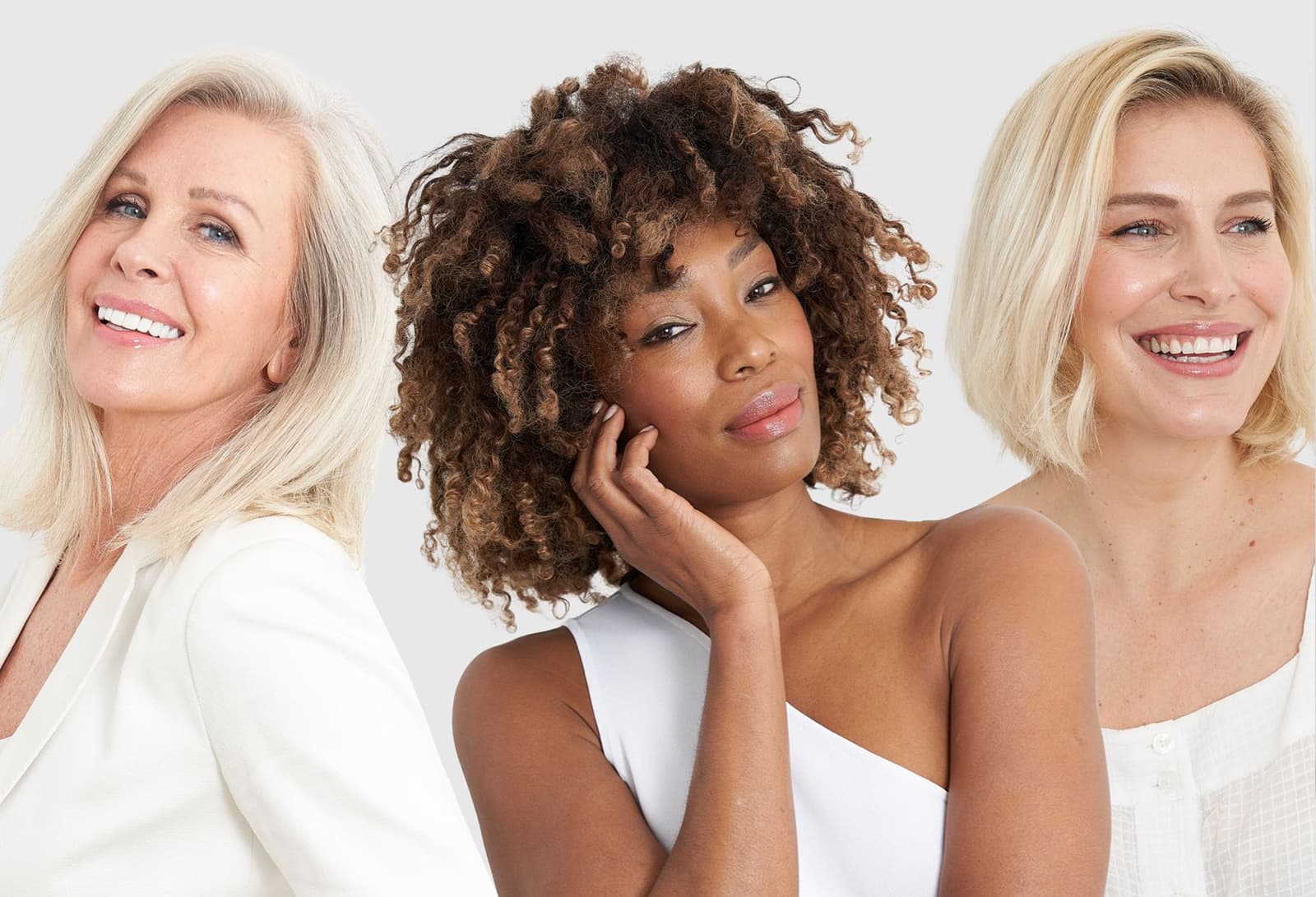
Beauty (and society), unfortunately, fetishizes youth. Whether it’s the lack of mature women’s roles in Hollywood or the 20-year-old model advertising anti-wrinkle cream, one might assume that people of a certain age just retreat into hobbit holes past a specific milestone birthday. But rather than becoming dwellers of Middle Earth, the mature beauty consumer holds the most spending power and is famished for brands that allow them to continue living their cosmetic life fully, rather than being forced to tone down from the equivalent of a size 8 to a size 4 on the makeup scale. Some are even calling for the anti anti-aging revolution.
Menopause-orientated wellness offerings have seen a huge surge, expected to reach $16 billion by 2025. With conversations opening up to this previously silenced stage of women’s lives and brands like Womanness or LaMaria offering modern and chic products that are infusing the category with excitement and helping drive conversations around age-inclusivity. But even though there are a variety of external effects this hormonal stage can have such as drier skin or increased pigmentation, there is more to being a woman of a certain age than menopause, such as evolving makeup routines.
A 2019 AARP online survey across 1,992 women found that 40% of Gen X and 53% of Boomers feel ignored by the beauty industry and 64% of Gen X and 74% of boomers feel the representation of their age demographic is lacking. Twelve percent of women over the age of 50 believe there are not enough products tailored towards their needs, while 70% of women over the age of 40 desire more perimenopausal and menopausal personal care products.
While not everyone is wearing a bold red lip à la Iris Apfel, still having the opportunity to do so is nonetheless appreciated. Yes, there are the realities that certain makeup will sit differently on skin with a few more beauty marks left by the passing of time, but does that mean that older women need to be denied the joys of colorful beauty? Certainly not if color cosmetic brand 19/99’s imagery—which features faces of all ages and ethnicities wearing the company’s boldly hued products—is anything to go by.
Aside from embracing the joys of makeup, there is also a huge economic component. The 2023 FIT Cosmetics and Fragrance Marketing and Management Capstone Research spotlighted the “Silver Spender” as the fastest growing segment with 50% of the global net worth but most underrepresented consumer group worldwide. By 2030, the silver consumer segment (those above the age of 50) is expected to spend $15 trillion. The number of US adults over the age of 65 will double in the next 40 years. The anti-aging market is expected to hit $106.65 billion by 2030.
Global brand design and innovation agency LPK recently highlighted the power of the Gen X consumer and the shifting social tides meaning this generation is “moving from invisibility to center stage,” 81-year-old Martha Stewart gracing the cover of Sports Illustrated being just one example. It’s not just celebrities embracing the later stages of life: LPK outlined a collective shift of middle age and up consumers embracing these chapters of their life with a new gusto, and increased product and service offerings to match. It’s about living longer, yes, but also living better.
“Longevity allows us to discuss the process of growing older more openly. Can it also help us to develop a language around aging that is more inclusive and celebratory? Introduce the concept of living a longevity lifestyle gradually, subtly, and optimistically and with products that focus on healthcare benefits,” The Future Laboratory’s Lead Beauty Analyst, Olivia Houghton, advised BeautyMatter readers when discussing the strategic agency’s new macrotrend Longevity Lifestyles.
A Different Formula
In recent years, a brigade of more age-inclusive beauty (and corresponding advertising) have been on the rise, driven by brands like Jones Road Beauty, Trinny London, Iris&Romeo, and Studio10. While not all of these companies advertise themselves as exclusively for a mature audience, skincare-infused formulations, a more subdued color palette, and minimalist packaging are trademarks of the 40+ audience product range.
Funnily enough, certain formulation and aesthetic traits (sheer and often cream formulas with skincare benefits, no makeup-makeup) can also be seen across more millennial brands like Glossier and e.l.f. or Gen Z-orientated outings like Rare Beauty. Perhaps the distinction between customer age demographics is becoming as blurred as the effects of the finishing powders they use. Nonetheless, even if teenagers and boomers end up reaching for the same subtle makeup products, brand messaging and advertising are certainly where the lines get more drawn. After all, as the saying goes: When you try to be everything to everyone, you become nothing to no one.
Building an Age-Inclusive Business
Founder Trinny Woodall began her business in 2017 with multitasking products in travel-friendly formats. Bestselling SKUs include BFF Eye, a serum concealer with Duo Peptide Complex and hyaluronic acid, as well as Miracle Blur, a base product to smooth fine lines and prevent lipstick bleeding. The brand’s lookbook features 130 people aged 18 to 83. Given its anticipated revenue for this year is $75 to$100 million, it’s a strategy that has been paying ample dividends.
“We know that over-50s have a higher spending power than the younger consumer. Over-50s are some of the biggest buyers of beauty and skincare products worldwide. Building on Trinny’s founding ethos and developing a raw and honest approach to makeup and skincare that celebrates authenticity and inclusivity, we’ve successfully tapped into the often neglected 35+ market. Customers of all ages return to us because they see themselves reflected in the brand and in our products,” Shira Feuer, Chief Marketing Officer at Trinny London, tells BeautyMatter.
Iris&Romeo founder Michele Gough Baril was inspired to launch the brand in 2019 following a departure from the industry due to the lack of representation. “I knew there was a white space to include women over 40 in a new, more relevant way, and I knew it was a huge opportunity because she has more purchasing power than any other generation and is the most loyal customer in beauty. But what was truly exciting for me was the opportunity to shift the aging conversation away from ‘anti-aging’ and toward skin wellness. Life doesn’t end at 40. In fact, this is when we truly come into ourselves, our power, and younger women need to see this so we can remove the fear about getting older,” she explains.
Iris&Romeo focuses on multitasking, sustainable, clean formulas that offer a hydrated, minimal makeup look. Think a second-skin concealer infused with Vitamin C from kakadu plum, hyaluronic acid, and licorice root extract; a glowy mineral SPF 50 which offers skincare benefits and also acts as a primer, available in a universal shade with no white cast; and a multiuse color balm with ceramides and free-radical fighting skincare ingredients.
Grace Fodor, founder of Studio10, also saw a business boom hiding in plain sight. “In terms of the beauty opportunity for that midlife consumer, it’s absolutely massive,” she enthuses. “It’s interesting because when you look at the beauty industry in the last five to ten years there’s been a real focus on millennials, then we saw the big explosion in direct-to-consumer (DTC) and celebrity, Instagram-focused brands. It’s almost as though the beauty industry became obsessed with that and they were beginning to forget that middle-age market even more.”
Studio10 was her bid to create skincare makeup formulated for mature skin, simplifying daily makeup routines, underpinned by slogans such as “For women who believe that age does not limit one’s sense of beauty” and “beauty is ageless.” SKUs include a 5-in-1 sunscreen, primer, skin tint, and treatment, as well as liquid blush that simultaneously plumps the skin and absorbs excess oils. “I designed the brand for mature skin. I look at the ingredients, texture, finish, undertones, and lifestyle. It’s about tailoring all of it according to your audience,” Fodor adds. “Studio10 is about building a successful brand that has longevity. At the core of it is high-performing products that work and are easy to use. Women want convenience. They don’t have time to spend an hour getting ready. You want results, but it needs to be quick.”
One of the brand’s bestselling SKUs is Skin Repair Perfect Canvas SPF30 Foundation, a medium to full coverage serum foundation in compact form with SPF 30 and antioxidant-rich nyamplung oil to fight free radicals. Fodor also ensured the product has a lighter and darker shade so customers can customize the product hue according to the time of year and have their optimal shade on hand at all times. Another popular product is Skin Lift Glow-plexion, a hydrating primer and illuminator formulated with Suberlift for a firming effect and a binding technology to ensure makeup longevity.
For Fodor, the mission of Studio10 goes beyond the product. “My passion and purpose is this pro age movement, to challenge the outdated stereotypes of middle age, what it looks like, the negative rhetoric it’s so outdated. The main point for me is stamping out ageism,” she explains. “Ageism is old news, but it’s the last ‘ism’ we really need to challenge. If you want to change the way we feel about aging, we have to change the rhetoric and the conversation. We have to reflect aging at 40, 50, 60, 70, 80, 90, and link it to beauty because the definition of beauty is not age.”
This post was originally published on this site be sure to check out more of their content.









